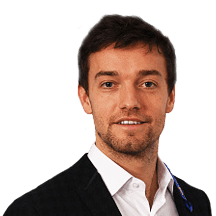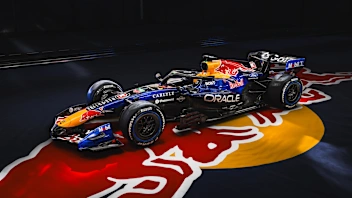The 2019 German Grand Prix: a thriller for spectators, but properly hard work for the drivers who had to spend nearly two hours living on their nerves in the cockpit (well, the ones that made it to the end, anyway). Here, former Renault F1 racer Jolyon Palmer explains just how difficult a race like the one we witnessed in Hockenheim is from a driver's perspective.
In the wet there are three main factors that make it much harder than the dry. Let's break down those factors, to see just why the 2019 German Grand Prix was so challenging.
Factor #1: Less grip
Firstly there is simply less grip. In Germany this was particularly tricky because the drivers hadn’t had any practice in the wet all weekend, or even all year. The first taste they were getting was in a couple of laps to the grid and then in full blown race conditions.
Throughout a conventional race weekend, the drivers have four hours practice to pound around setting laps, but with each lap they are honing their reference points for braking, gear usage and kerb usage.
In a dry race, even though they now have 100kgs of fuel in the car, they should know pretty much where to brake from their FP2 long runs, or even without that, because they are used to the offset from low fuel to high fuel by now.
READ MORE: The winners and losers of the 2019 German Grand Prix
In a wet race, this all goes out of the window. The drivers were having to learn on the fly where their brake points were, what gears to use and what kerbs to touch or stay well clear of.
This caught out Antonio Giovinazzi into Turn 2 on Lap 1, and a few laps later Pierre Gasly into Turn 6, as they missed their brake points and went wide, losing positions.
Factor #2: Varying levels of grip
The second issue makes life much harder again: the grip is different all of the time in the wet. With each lap, the track is changing, becoming drier in most parts, but some parts more than others, and some kerbs dry more quickly than others as well.
So unlike the dry where you know your reference from the first couple of laps, then you can simply push marginally harder and harder depending on the fuel load versus tyre performance trade off. In the wet you can push harder in some parts, but other parts remain wet and treacherous, like Turn 16 at Hockenheim, which caught a number of drivers out.
There is a slope running down from the T14/15 chicane before it and that meant more water was collecting at T16. Add into the mix the soapy, slippery run off, which the drivers would also not have expected, and this became the danger zone for most of the Grand Prix.
Hamilton paid a big price when he went off at Turn 16 – but he was lucky not to be out on the spot
For the likes of Charles Leclerc and Lewis Hamilton, they went off here on slick tyres, both on their out-laps. They would have driven much of the lap and established a feeling for the conditions and got back to Turn 16 at the end of the lap and underestimated how wet it was, and simply slithered off the circuit.
Hamilton’s incident was actually under Safety Car, which shows quite how wet the corner was. Tyre temperatures drop quickly when driving a Formula 1 car at reduced pace. Hamilton was cruising around the stadium sector, but just a slight tickle of the throttle pedal out of Turn 15 meant he had too much speed in the section of the circuit that was the most perilous. He paid a big price, but was lucky not to be out on the spot.
Factor #3: Spray
The third issue that you usually get in the wet is the spray. Actually in Germany this didn’t appear to be so bad after the early laps. But potentially Gasly’s off at Turn 6 can be attributed to this a bit as well.
When you are in the middle of the pack in even moderately wet conditions, the spray becomes intense. You never notice it under the Safety Car, but as soon as cars are unleashed to true racing speeds you become almost blindfolded on the straights and have to do a lot of educated guess work as to where corners and rivals might be.
From the onboard shots we see it looks bad, but inside the helmet at near ground level, I assure you, it is 10 times worse!
Gasly wouldn’t have had this issue if he’d have held his fourth place position off the line – another benefit those at the front have. But in dropping back, he was in the melee and in the spray, and went off trying what looked like an extremely overzealous move around the outside of four cars at Turn 6. Surely he either couldn’t see or simply misjudged his grip and braking distances.
...and the drivers have to stay on top of strategy
Finally, on top of all of this hard work to keep the car on the track, keep learning and improving with each corner and race hard wheel to wheel, the drivers must also be aware of the strategy.
Changing to the right tyres at the right time is critical in mixed conditions, and we couldn’t get a clearer example of that than at Hockenheim.
Lance Stroll called his pit stop for slicks, and went from the back of the field to the lead as he called the gamble perfectly.
Daniil Kvyat and Kevin Magnussen were the first to follow suit and also reaped the rewards, particularly Kvyat.
There was so much that could go wrong in a race like this
On the other side, Hamilton and Mercedes were left flat-footed. Hamilton did two extra laps on the inters, in addition to taking a five-second penalty, but when he emerged from the pits he had fallen from third to outside of the points.
So in the mixed up conditions, while we get to sit back and watch a thrilling race, the drivers and teams are working ferociously for the best part of two hours, trying to maximise everything. But ultimately in Hockenheim, it was more about minimising mistakes, because there was so much that could go wrong in a race like this.
Next Up

.webp)
.webp)


.webp)
.webp)